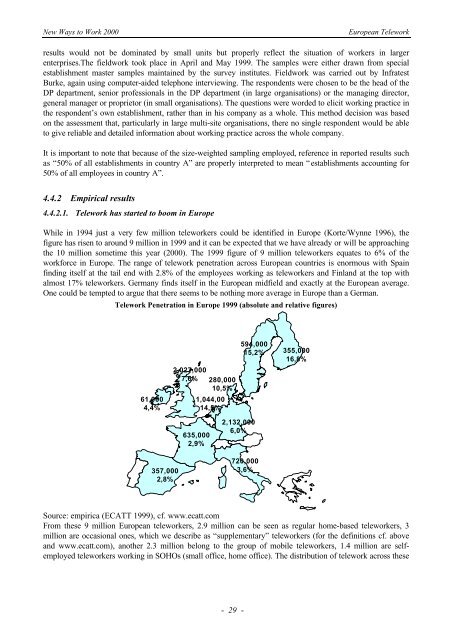eWORK 2000 - European Telework Week
eWORK 2000 - European Telework Week
eWORK 2000 - European Telework Week
- No tags were found...
You also want an ePaper? Increase the reach of your titles
YUMPU automatically turns print PDFs into web optimized ePapers that Google loves.
New Ways to Work <strong>2000</strong><strong>European</strong> <strong>Telework</strong>results would not be dominated by small units but properly reflect the situation of workers in largerenterprises.The fieldwork took place in April and May 1999. The samples were either drawn from specialestablishment master samples maintained by the survey institutes. Fieldwork was carried out by InfratestBurke, again using computer-aided telephone interviewing. The respondents were chosen to be the head of theDP department, senior professionals in the DP department (in large organisations) or the managing director,general manager or proprietor (in small organisations). The questions were worded to elicit working practice inthe respondent’s own establishment, rather than in his company as a whole. This method decision was basedon the assessment that, particularly in large multi-site organisations, there no single respondent would be ableto give reliable and detailed information about working practice across the whole company.It is important to note that because of the size-weighted sampling employed, reference in reported results suchas “50% of all establishments in country A” are properly interpreted to mean “establishments accounting for50% of all employees in country A”.4.4.2 Empirical results4.4.2.1. <strong>Telework</strong> has started to boom in EuropeWhile in 1994 just a very few million teleworkers could be identified in Europe (Korte/Wynne 1996), thefigure has risen to around 9 million in 1999 and it can be expected that we have already or will be approachingthe 10 million sometime this year (<strong>2000</strong>). The 1999 figure of 9 million teleworkers equates to 6% of theworkforce in Europe. The range of telework penetration across <strong>European</strong> countries is enormous with Spainfinding itself at the tail end with 2.8% of the employees working as teleworkers and Finland at the top withalmost 17% teleworkers. Germany finds itself in the <strong>European</strong> midfield and exactly at the <strong>European</strong> average.One could be tempted to argue that there seems to be nothing more average in Europe than a German.<strong>Telework</strong> Penetration in Europe 1999 (absolute and relative figures)61,0004,4%2,027,0007,6%280,00010,5%1,044,0014,5%594,00015,2% 355,00016,8%635,0002,9%2,132,0006,0%357,0002,8%720,0003,6%Source: empirica (ECATT 1999), cf. www.ecatt.comFrom these 9 million <strong>European</strong> teleworkers, 2.9 million can be seen as regular home-based teleworkers, 3million are occasional ones, which we describe as “supplementary” teleworkers (for the definitions cf. aboveand www.ecatt.com), another 2.3 million belong to the group of mobile teleworkers, 1.4 million are selfemployedteleworkers working in SOHOs (small office, home office). The distribution of telework across these- 29 -








